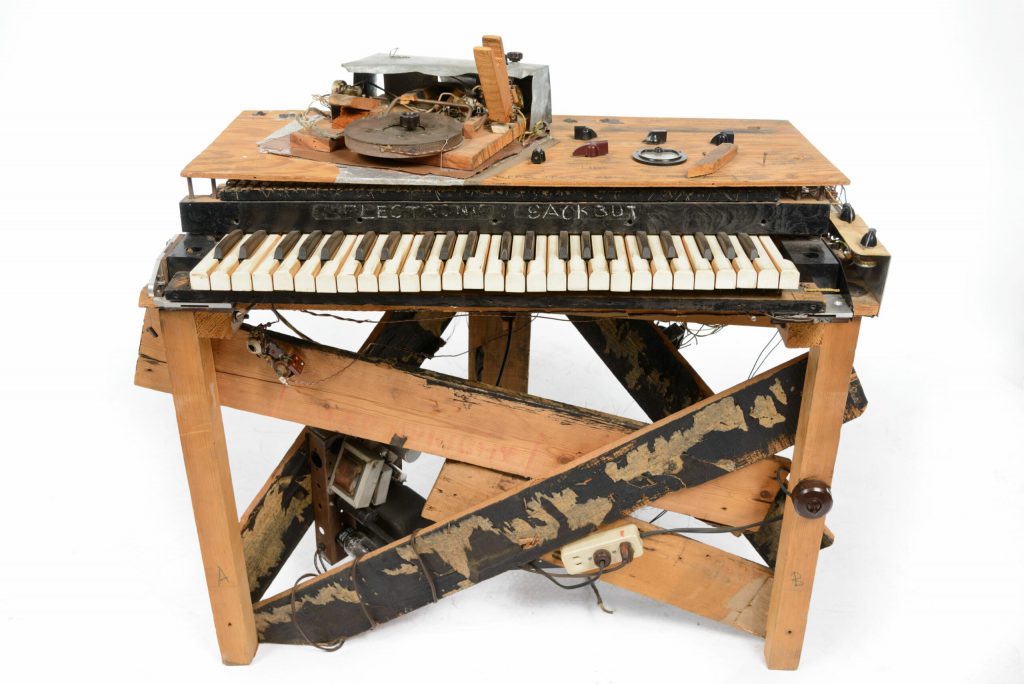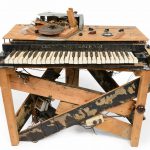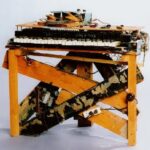Artefacts
Electronic Sackbut
Electronic Sackbut
(Accession Number: 1975.0336)
Condition: Mechanical components in fair condition, with some exceptions.
Electronic components in fair to poor condition. Instrument is inoperable in current state, though a conservation/reconstruction project is underway.
The Electronic Sackbut, designed by Canadian physicist Hugh Le Caine, is the world’s first known voltage-controlled synthesizer. It employed various techniques in electronic signal processing – among them the generating, dividing, filtering, modulating, and blending of electronically-produced waveforms – to permit new ways of creating and controlling musical sound. These techniques both inspired and foreshadowed future commercial synthesizer designs of the 1960s and 70s, making the Electronic Sackbut an important early contribution to the history of electronic musical instruments.
The Electronic Sackbut is a monophonic synthesizer, meaning it can produce one tone at a time. Pitch and volume are controlled by a touch-sensitive keyboard, operated by the musician’s right hand. The keyboard has 49 keys and is touch-sensitive on two planes: vertical and horizontal. Pressing harder or softer vertically on a key produces a louder or softer tone. Pressing harder or softer horizontally on a key produces a stronger or weaker deviation in the key’s main pitch: either slightly lowering the pitch (pressing to the left) or raising the pitch (pressing to the right). Adjusting finger pressure rapidly (side to side) produces a vibrato effect, similar to that achieved by a violinist.
Timbre is controlled in a number of ways, most notably via the manual movement of a circular metal plate by the left hand, while the right hand generates a desired tone (or note) on the keyboard. This metal plate rests upon a second (conductive) plate, to which is connected a series of inputs distributed around its perimeter, each introducing a distinct electronically-produced waveform. The position of the top plate in relation to the bottom plate determines the relative strength or weakness of each of the distinct waveforms being fed into the bottom plate. By sliding the top plate in different directions, the player can adjust precisely how the different waveforms are blended – or synthesized – in order to create a single (outputted) waveform of a particular shape or timbre. The position of the plate, and corresponding shape of the outputted waveform, can be set in advance or slowly changed during playback, an innovation that allows continuous control of a sound. Le Caine’s 1953 composition The Sackbut Blues, demonstrates the instrument’s fluid waveform controls.
Other adjustments to pitch and timbre – as well as additional expressive elements, such as temporality (e.g. the timing of attack, glide) – are made possible by an array of manual controls on the instrument’s main console. A foot pedal permits hands-free volume control.
Capacitance is key to almost every function of the Sackbut: voltages are changed gradually as two charged plates are brought into (and out of) proximity to control pitch, volume, and waveform. In his use of capacitance, Le Caine was expanding significantly on its use in earlier instruments such as the Theremin, and simultaneously translating his knowledge of wave physics and acoustics into the audio range, having previously developed related technologies for use in atomic physics, radar, and microwave radio transmission.
The Electronic Sackbut shown here is the prototype version of the instrument. It was designed and built by Le Caine in his home studio in Ottawa, Canada, between 1945 and 1948. In total, four unique versions of the Electronic Sackbut were produced. The second (begun in 1954) is today believed lost, and the final two (the last completed by 1973) are in the care of a private collector and in unknown condition/completeness.
Several recordings of the prototype being played were made by Le Caine and his colleagues between 1946 and 1954, and have been preserved. Due in part to the instrument’s successful demonstration of new possibilities for electronically-produced sound, the National Research Council of Canada (NRC) established the Electronic Music (ELMUS) Lab in 1954, the first electronic music studio in Canada and among the first in North America.
© 2015 – 2025 Humboldt-Universität zu Berlin








